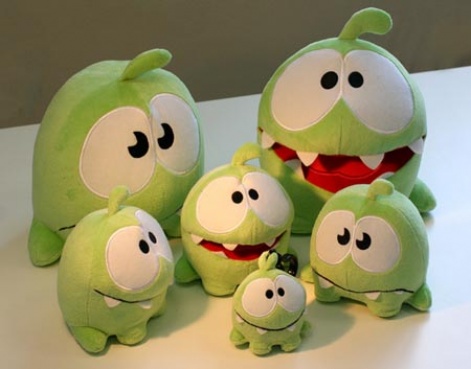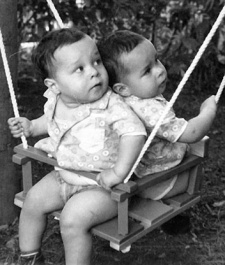While their flagship title has been downloaded over 100 million times, the names and humble beginnings behind the creation of Cut the Ropewill be a mystery to most gamers.
Russian twins, Semyon and Efim Voinov, are those creative minds, and they've had a lot of practise. They've been making games together since before they were ten.
In this interview, we look back at their early years - once again proving that, like Rovio and OMGPOP, the great 'overnight' success stories involve a lot of time and a lot of hard work - as well as getting a glimpse at their future.
Super Voinov Bros.
Although non-identical twins, the brothers have enjoyed a tight bond since early childhood, spending most of their free time together playing and later making games on their ZX Spectrum - a surprising choice given their Russian location.
"I loved The Great Escape, Dizzy and North & South," Semyon recalls.
"One of my favourite apps on ZX Spectrum wasn't even a game," Efim adds. "It was a music sequencer called Wham. The sound capabilities of my Speccy were worse than most of the cheapest phones, but it was very enjoyable to create music for our games and standalone tunes.
"As for games, I spent hours playing Nether Earth, in which you produced and controlled a group of customisable robots, fighting with an AI opponent. Many years later, I learned that it was considered to be one of the first real-time strategy games ever created."
Start to make
Still, thanks to a book on the BASIC programming language, it wasn't long before the young boys started to learn how to program and make games.
"While our friends were mostly playing games, we were actually developing and programming them," Semyon recalls. "It always seemed much more exciting for us."

Curious even at a young age
"We started creating our first games at the age of 8 or 9," Efim adds.
"At that time, we often went skiing with our parents, so one of the first games we made was a ski racing game - with very simple graphics and UI. It was a lot of fun for us to bring our real life experience to digital format."
"When I created my first game on the ZX Spectrum, I remember there was a space ship and an asteroids heading to it," Semyon continues. "The goal was to avoid the asteroids and fly as long as possible. I don't think I ever actually gave it a name."
Wintel arrives
The Spectrum didn't last forever, of course, superceded by the PC. The twins didn't have a PC at home, but were brought to their parents' office to play games on the computers there.
"We used to go and play games like Prince of Persia, Gremlins and Civilization," Semyon recalls, explaining that their parents were working as scientists at the high energy physics research centre, the Kurchatov Institute, which is where the Soviet nuclear project was developed in the 1950s.
Still, when 8-bit consoles arrived in Russia, the Voinovs got their share through a fake Chinese knock-off console called Dendy, (which are still being sold today).
"It was running Nintendo games but it would have Chinese packaging," Semyon explains. "There were no official Nintendo in Russia. Just this stuff. It was pretty cool, we got the games, so we didn't complain."
Portable opening
Fast forwarding to 2003, the brothers quickly embraced the era of Palm PDAs.
"We saw an opportunity when Palm devices and Palm OS came out," Semyon says.
Calling themselves Muddy Glass, they starting making simple Palm OS games such as Spy Chase 3D.
Spy Chase 3D

"It was a tribute to Deathchase, one of the games we grew up with on the ZX Spectrum," he explains.
"We added some new features and introduced a basic storyline, while trying to retain the original addictive gameplay that we liked so much."
Other Palm games made included Evil UFOs, as well as animation software NoviiAnimator.
Screens from Evil UFOs
"You could draw the frames of animation and then play a movie. It was popular and some US schools even used it as educational software," Semyon says.

"We didn't get much money from it, but still it was very nice kind of experience for two students."
Smell the coffee
The big change happened, however, when the brothers discovered Java. They dove into it right away.
"We started working for an American company called Reaxion, which had an office in Moscow making traditional mobile games," Semyon says.
"I really liked doing pixel art. The challenge of having so many limitations makes it much more interesting to create games. You're challenged to get the maximum out of what you have."
The brothers ended up working on over 20 mobile games, but after spending three years at Reaxion with his brother, Semyon eventually left.
"I felt I had got to highest level possible there and I wanted to move on," he explains.
"I wanted to learn more and there weren't a lot of opportunities for that in Moscow, or in Russia. So I started looking for work abroad and found several opportunities. I actually applied to Rovio, but it never replied. Of course, it wasn't so popular back then."
The wanderer
Instead, Semyon found opportunities in France and Canada, but making this move turned out to be more difficult than he thought. Eventually, in 2007, he got a job at Digital Chocolate in Helsinki.
"Finland seemed the most reasonable choice, because it was closer to Russia," he explains. "My family liked it better - we're still living in Russia and my girlfriend was there as well."
Nevertheless, it wasn't plain sailing.
"It was really cool and stressful at the same time," he admits. "I had never lived abroad. I had never lived separately from my parents or my brother, and my English wasn't that good."
Semyon (left) and Efim (right)
Nevertheless, Semyon was enamoured with Digital Chocolate's corporate culture, where he was inspired by the management style of then-studio president Ilkka Paananen [now at Supercell].
"I was trying to apply the lessons I learnt from him - about the structural and cultural aspects of setting up a company - when we were building up ZeptoLab in Moscow" says Semyon.
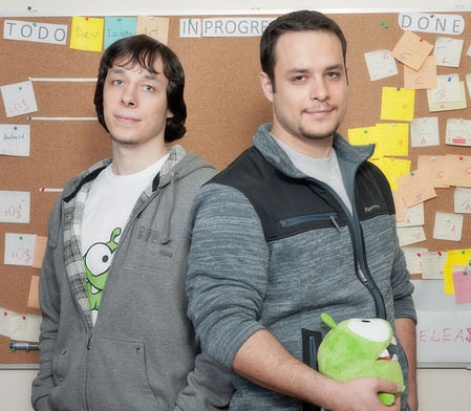
"I really loved the culture within the company, and the fact that there were people from so many countries. It was multicultural and that was an awesome experience."
Eye wide open
This fed into Semyon's work too.
"I believe spending time in other countries and cultures is a great experience for your personality," he argues.
"It widens the way you see things so much. I am sure that Cut The Rope wouldn't have been possible without my experience at Digital Chocolate. It wasn't only about the technical or artistic things I learned there, though, but also about understanding different cultures.
"Understanding what people want is important when you're making a casual game, a game for a wide audience. Living in Russia, you only know Russians and don't have a complete picture of what kind of style or jokes foreigners like."
Back home
As with Reaxion, Semyon spent three years at Digital Chocolate before moving on again.
"Having reached the lead artist position, I didn't feel that there were more career or learning possibilities for me," he explains. "But I've always enjoyed working with my brother and it was quite easy for us. Communication comes naturally.
"And because he's a programmer and I'm an artist, it was a great collaboration between the two of us."
Meanwhile, back in Moscow, Efim's desire to start his own business was fuelled by his discovery of the up-and coming mobile devices.
"At that time I decided to switch my old cell phone for something new and had already eyed the iPhone," he says.
"I never had an Apple product before and it was interesting to give it a try after hearing various opinions from my friends and colleagues. The phone offered much more capabilities compared to the old feature phones I used to work with.
"When the App Store was opened and allowed independent developers to enter the market quite easily, I felt that I couldn't miss this opportunity."
Efim's first title under the ZeptoLab name was iPhone game Parachute Ninja, which he created together with several contractors.
Ninja Parachute screens
Published by US company Freeverse (and gaining some good reviews), it enjoyed reasonable success, being downloaded more than 3 million times.
"At that time, I had already spent several years working at Digital Chocolate and I felt that maybe it was time to move on," Semyon admits.
With his brother off to a great start with ZeptoLab, the two reunited to create the studio's second title Cut The Rope.
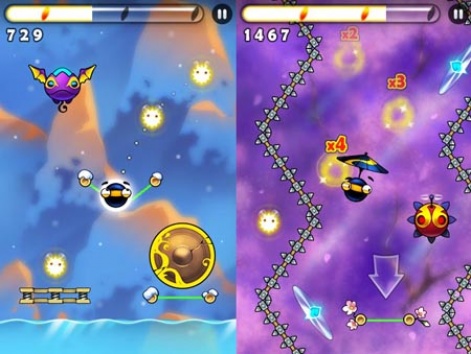
No dope rope
The foundations that make Cut the Rope such a fun game didn't appear out of the blue. They originated from Efim's design for a special rope mechanic he had had in mind for a long time.
"We made several prototypes of the games based on that rope mechanic," he explains.
"The Cut the Rope concept received most votes from us and our friends, so we decided to go with it. Being brothers definitely helps us understand each other quickly and allows to express our thoughts without any barriers.
"So our constant brainstorming sessions during the development were quite productive. That's an important part of the game's success."
During their work on Cut The Rope the Voinov brothers adopted the theory put forward by many Russian industry veterans.

"They said you have to release at least seven titles before you get a hit," Semyon explains.
"That is - you have to produce several titles, and then hope that one of them will be sold well. So we were thinking we'd release this game and then we'd do another one and we'd continue doing games until one of them becomes really popular."
Still, while the brothers believed they had something interesting on their hands, the game's success was unexpected.
"We were definitely surprised at Cut The Rope's success," Semyon admits, of the game which was released by Chillingo on iOS in October 2010. ZeptoLab has since gone on to release it on Android, Windows Phone, BlackBerry PlayBook, HTML5 and smart TV, amongst others.
"Of course, we were doing our best to make the game as good as possible. Sometimes you really put your soul into the game and it's just a flop. And sometimes you don't really believe that the game will be successful, and suddenly it's a big hit."
With Cut The Rope, the pair had a gut feeling they were making something with a lot of potential, but at the same time neither could shake an accompanying sense of uncertainty.
"Of course we were hoping that it would reach the top of the charts and bring a lot of sales, but we were ready for a different destiny," says Semyon.
"Parachute Ninja was successful on its own terms, so we were expecting something of the same scale. It was a pleasant surprise when it became a hit, but we also suddenly got involved in lots of business conversations. We had to expand the company, but we didn't want to lose the feeling of being small."
Balanced brotherhood
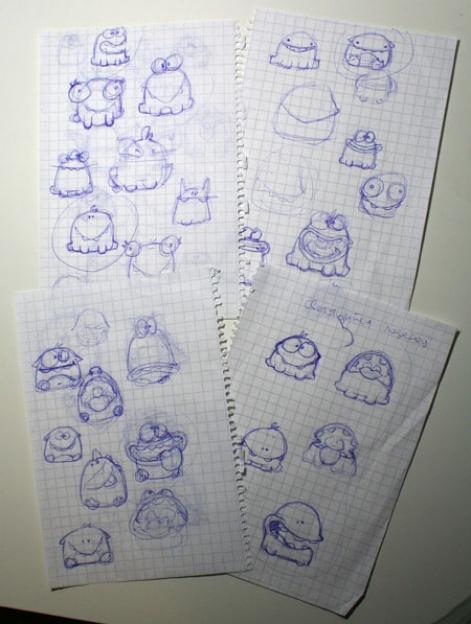
How much did being twins contribute to Cut the Rope's success?
It's hard to say, but there are many brothers in game development, and Semyon reckons such companies do have an advantage.
"You can completely trust each other," he points out. "In our case, when things become really stressful, I might can argue a lot with Efim. I can yell at my brother. He can express his emotions too. But if he wasn't my brother, I'm not sure if both of us would be able to forgive such things.
"We've known each other since we were born. You fight. You get a set of bruises. The next day you forget about it. You're like best friends again. You need a healthy kind of communication.
"As brothers, we don't have any barriers in communication. If something is crap, I can say it right away, without trying to smooth it out for Efim."
In terms of their future, it's a balance of expanding the Cut the Rope franchise with updates and most recently merchandising, while evolving the company into a full fledged development studio.
Sadly, such success means their next project - a completely new concept and prototype - has been on hold, laying dormant for several years.
A lot of Om Nom plushies
But with the appointment of ZeptoLab's CEO Mischa Lyalin and - more recently - the Cut the Rope franchise being managed by ZeptoLab's new head of merchandising Tanya Haider, the Voinov brothers are gearing up to announce new projects within the year.
"We have around 30 people now and are growing rapidly," Semyon says. "While putting a lot of effort into regular introduction of new features and content in Cut the Rope world, we are excited to release new titles this year as well."
"Making games is both my hobby and job," Efim explains. "It's an inseparable part of my life that I would like to continue in terms of growing personally and seeing the company's progress."
"It's the same for me. I'm planning to continue making games," Semyon adds.
You can find out more about the brothers' history on Semyon's old website, while there's a Casual Connect lecture about the process of developing Cut the Rope here
